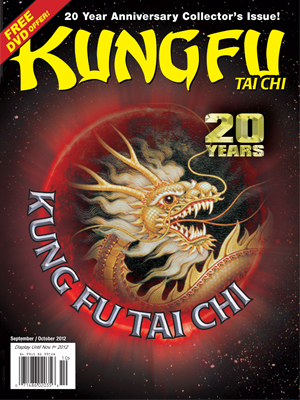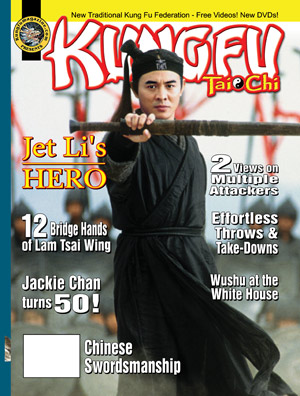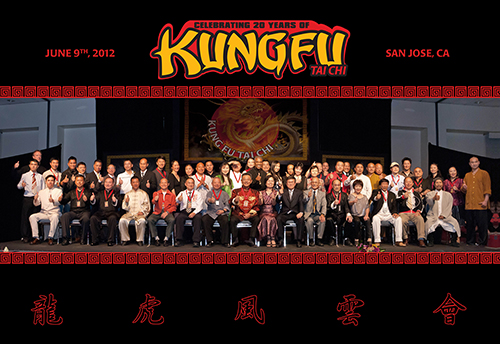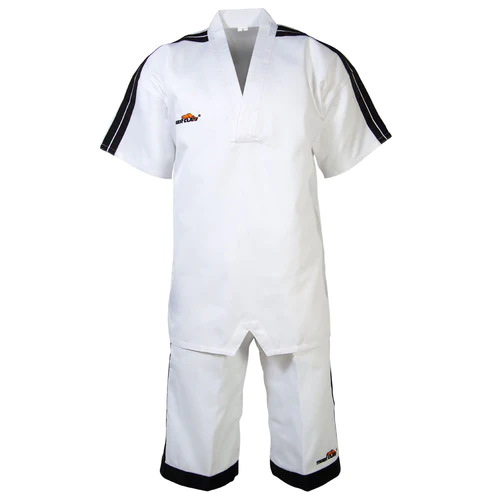By Gene Ching
Buy this issue now , or download it from Zinio
 The story of Kung Fu Tai Chi magazine actually begins in 1985 when Thomas Oh founded Tiger Claw Martial Arts Safety Products and Supplies. Originally called Pioneer Interstate, Tiger Claw began in San Carlos with three employees and two phone lines. From selling goods tournament to tournament out of the back of his van, Mr. Oh built one of America's largest martial arts supply companies. Today, Tiger Claw is headquartered in Fremont, California, where the Kung Fu Tai Chi production office and studio is also located. Tiger Claw also has an East Coast office in Knoxville, Tennessee.
The story of Kung Fu Tai Chi magazine actually begins in 1985 when Thomas Oh founded Tiger Claw Martial Arts Safety Products and Supplies. Originally called Pioneer Interstate, Tiger Claw began in San Carlos with three employees and two phone lines. From selling goods tournament to tournament out of the back of his van, Mr. Oh built one of America's largest martial arts supply companies. Today, Tiger Claw is headquartered in Fremont, California, where the Kung Fu Tai Chi production office and studio is also located. Tiger Claw also has an East Coast office in Knoxville, Tennessee.
The premiere issue of Kung Fu Tai Chi, then titled Kungfu Wushu, hit the newsstands on February 17, 1992, two weeks after the start of the Year of the Water Monkey. That first issue was 80 pages, the bulk of which was printed on newspaper-grade stock. It was saddle-stitched with a few color pages inserted on magazine-grade stock. Those color pages were used for lead pages in select articles and ads. It was a quarterly publication, and in the fall, a sister magazine titled DOJO premiered. DOJO covered Japanese arts.
In 1994, Gigi Oh, Thomas's wife, took over as publisher. Later that year, another magazine was added, DOJANG, which covered Korean arts. Kungfu Wushu, DOJO and DOJANG alternated as quarterlies so that there was a fresh issue on the newsstands every month. In 1995, Kungfu Wushu absorbed another fledgling publication titled Wushu Qigong and changed the title to Kungfu Wushu Qigong. The following year, Kungfu Wushu Qigong switched from quarterly to bimonthly. Senior Graphic Artist Patrick Lugo joined the production crew. For 58 installments, Patrick produced a comic strip for Kungfu Wushu Qigong titled Tiger's Tale. DOJANG and DOJO were merged into a bimonthly magazine titled World of Martial Arts. Like before, Kungfu Wushu Qigong and World of Martial Arts alternated as bimonthlies to keep it fresh on the newsstands each month. The year after that, 1996, Associate Publisher Gene Ching had his first freelance submission published in Kungfu Wushu Qigong. At that time, Gene's submissions were published in all the leading martial arts magazines as a freelance writer.
On June 30, 1997, Britain returned Hong Kong to the People's Republic of China. That historic event had global repercussions. Within the Chinese martial arts world, the most dramatic impact came from the martial arts filmmakers. Fearing PRC censorship, many HK filmmakers tried to break into Hollywood, with marginal results. The following year, the first extra-issue special was published. The cover featured Bruce Lee and it was one of the top-selling issues so far. The following year (two years after the turnover), a second extra-issue special was published - Hong Kong Meets Hollywood. Just prior to that special, Kungfu Wushu Qigong published a regular issue that featured Lawrence Fishburne on the cover for Matrix. It did quite well on the newsstands just prior to that special. Unfortunately, Hong Kong film was fizzling, and with Keanu Reeves on the cover of that special, it underperformed. Kungfu Wushu Qigong attempted two other extra-issue specials, one on Shaolin and the other on the 10 Year Anniversary. The Shaolin special did well, as they always do. Despite being packed full of facts and history, the performance of the anniversary issue was mediocre.
Specials tend to perform best on the newsstands, so there were several different thematic specials. Beyond the Hong Kong Meets Hollywood special, there have been few specials on both Tai Chi and Wing Chun, as well as some single special issues focused on topics like animal styles, Chin Woo - Huo Yun Jia, Outlaws of the Marsh and Wudang. We even did a Police Special and a Sword Collectors' Special. Only one delivered enough newsstand sales and was supported by enough talented contributors to be sustainable. That was the Shaolin Special. The first Shaolin Special was published in 1999 and it has continued on a more-or-less annual basis. Some years got two Shaolin Specials while others were skipped. Last April, the 13th annual Shaolin Special hit the newsstands.
But back to 1999, Gene Ching was covertly added to the magazine staff for the December issue, which was a Shaolin Special, albeit a regular issue. Announcement of his position on staff was withheld until the extra-issue special, released in 2000. The turn of the millennium was a Year of the Dragon. Accordingly, it was a pivotal year for the magazine and Chinese martial arts.
In late 1999, World of Martial Arts ceased publication and Kungfu Wushu Qigong became monthly. The January 2000 issue of Kungfu Wushu Qigong covered "Kungfu's TOP 100 Martial Arts of the Millennium" in which 100 different styles of Kung Fu were listed. It was one of the bestselling issues in the history of the magazine. The magazine became perfect-bound and jumped to 132 pages, color and black and white.
 In February 2000, Feng Shui master Wilson Sun joined the staff. He initially produced articles on Feng Shui applications in the martial arts, such as a popular four-installment series on how to properly arrange a Kung Fu school. By the end of the year, he found his niche writing Kung Fu Horoscopes, the first horoscope based on the Chinese Zodiac to be published in English. Kung Fu Horoscopes remains a favorite column within the magazine. In March, the term "Wushu" was dropped from the title so the magazine became Kungfu Qigong. Wushu had a stigma of being too flowery amongst the traditional Kung Fu circles and it wasn't entering the American vernacular as quickly as hoped. Furthermore, it was getting difficult to include a Wushu article in every issue, so the term was cut from the title as being extraneous. Kungfu Qigong continues to cover Wushu; it was just removed from the title. In September, Graphic Artist Kevin Ho joined the crew, completing the magazine production staff as it stands today. Along with his graphic skills, Kevin brings another much-needed skill, fluency in Cantonese. The December issue ended the year with a story parallel to the January issue, "Kungfu's Top 100 Weapons."
In February 2000, Feng Shui master Wilson Sun joined the staff. He initially produced articles on Feng Shui applications in the martial arts, such as a popular four-installment series on how to properly arrange a Kung Fu school. By the end of the year, he found his niche writing Kung Fu Horoscopes, the first horoscope based on the Chinese Zodiac to be published in English. Kung Fu Horoscopes remains a favorite column within the magazine. In March, the term "Wushu" was dropped from the title so the magazine became Kungfu Qigong. Wushu had a stigma of being too flowery amongst the traditional Kung Fu circles and it wasn't entering the American vernacular as quickly as hoped. Furthermore, it was getting difficult to include a Wushu article in every issue, so the term was cut from the title as being extraneous. Kungfu Qigong continues to cover Wushu; it was just removed from the title. In September, Graphic Artist Kevin Ho joined the crew, completing the magazine production staff as it stands today. Along with his graphic skills, Kevin brings another much-needed skill, fluency in Cantonese. The December issue ended the year with a story parallel to the January issue, "Kungfu's Top 100 Weapons."
In 2001, Kungfu Qigong went back to being bimonthly. With the rise of the internet, that production time was dedicated to launching the official website, KungFuMagazine.com. TC Media owned the website address but didn't do much with it until the relaunch on February 2, 2001. That date was picked to coincide with the Chinese New Year celebrations for Year of the Snake. Funded by TC Media's retail outlet, MartialArtsMart.com (a Tiger Claw distributor), KungFuMagazine.com thrived as a website without having to rely on outside advertising. In March, Crouching Tiger, Hidden Dragon won four Academy awards, which gave Kung Fu a good bump in sales. The martial community was thriving until the 9/11 attacks, which increased travel restrictions, squelching tournament attendance and international exchanges.
 Kungfu Qigong celebrated its 10 Year Anniversary in 2002. With brewing excitement for the 2008 Beijing Olympics and the dream of Wushu becoming an Olympic event, the Anniversary was a benefit for the U.S. Olympic Wushu Team. Unfortunately, Wushu was not included as an Olympic event. Wushu Tournament Beijing was held as a nod to the sport, but it received no coverage other than within this magazine. Nevertheless, $20,000 was gathered from the Anniversary and used to help fund the athletes for Wushu Tournament Beijing. This was also the launch of the Tiger Claw Foundation. Immediately following 9/11, MartialArtsMart.com appeared in the top ten as a source of flags in a major internet search engine. Flag inventory, which would have usually lasted two years, was sold out instantly. Tiger Claw donated the proceeds of the sales directly to the Red Cross. More patriotic goods, such as mugs and t-shirts, were created solely to generate more funds for this cause. After the sales rush subsided, Tiger Claw reviewed its history of charitable contributions and it was determined that a formal non-profit foundation must be established to continue our grassroots support efforts. The Tiger Claw Foundation's first project was the 10 Year Anniversary.
Kungfu Qigong celebrated its 10 Year Anniversary in 2002. With brewing excitement for the 2008 Beijing Olympics and the dream of Wushu becoming an Olympic event, the Anniversary was a benefit for the U.S. Olympic Wushu Team. Unfortunately, Wushu was not included as an Olympic event. Wushu Tournament Beijing was held as a nod to the sport, but it received no coverage other than within this magazine. Nevertheless, $20,000 was gathered from the Anniversary and used to help fund the athletes for Wushu Tournament Beijing. This was also the launch of the Tiger Claw Foundation. Immediately following 9/11, MartialArtsMart.com appeared in the top ten as a source of flags in a major internet search engine. Flag inventory, which would have usually lasted two years, was sold out instantly. Tiger Claw donated the proceeds of the sales directly to the Red Cross. More patriotic goods, such as mugs and t-shirts, were created solely to generate more funds for this cause. After the sales rush subsided, Tiger Claw reviewed its history of charitable contributions and it was determined that a formal non-profit foundation must be established to continue our grassroots support efforts. The Tiger Claw Foundation's first project was the 10 Year Anniversary.
 In the middle of 2003, Kungfu Qigong made one final title change to Kung Fu Tai Chi. While qigong had spread throughout America, the term had not. Tai Chi is far more recognized, so to address the internal aspects of the magazine, the change was made. Gary Shockley, a former Kung Fu instructor and award-winning Science Fiction writer, took the position of copy editor. After being invited to a showcase of Taiwanese martial arts, Gigi spearheaded a series of articles featuring "the Treasures of Taiwan" that carried over into the following year. That year, 2004, Kung Fu Tai Chi also celebrated the 30th Anniversary of Wushu at the White House. This was a series of feature articles about masters who were present at the historic performance of the Wushu delegation that helped open China and American relationships. The series timed out perfectly with the release of Hero, as Jet Li was the most famous member of that delegation.
In the middle of 2003, Kungfu Qigong made one final title change to Kung Fu Tai Chi. While qigong had spread throughout America, the term had not. Tai Chi is far more recognized, so to address the internal aspects of the magazine, the change was made. Gary Shockley, a former Kung Fu instructor and award-winning Science Fiction writer, took the position of copy editor. After being invited to a showcase of Taiwanese martial arts, Gigi spearheaded a series of articles featuring "the Treasures of Taiwan" that carried over into the following year. That year, 2004, Kung Fu Tai Chi also celebrated the 30th Anniversary of Wushu at the White House. This was a series of feature articles about masters who were present at the historic performance of the Wushu delegation that helped open China and American relationships. The series timed out perfectly with the release of Hero, as Jet Li was the most famous member of that delegation.
In 2006, Tiger Claw launched the Tiger Claw Elite Championship (TCEC). TCEC was in cooperation with Disney, beginning and ending each year at the Disney Parks in California and Florida and travelling through about a dozen tournaments across the nation in between. TCEC featured divisions for Chinese, Korean and Japanese arts and were nested within other participating tournaments. The closest event to the Kung Fu Tai Chi offices was RDK's Ultimate Internationals, and the Chinese divisions quickly dominated TCEC for its three-year run. TCEC's final year was in 2008, just prior to the Sichuan quake. In only eleven days, the Tiger Claw Foundation called upon leading local martial artists and produced the Martial Arts Benefit for Quake Victims, a fundraising performance, to conclude the tournament event. The project raised over $73,000 which was donated to construct a new school in Sichuan.
In 2009, the local Chinese community wanted the tournament to continue, so Tiger Claw's KungFuMagazine.com Championship (TCKFMC) had its inaugural year. TCKFMC has enjoyed four successful events and looks forward to the future. The following year, the September October issue went full color. In addition, Kung Fu Tai Chi added official Facebook, Twitter and MySpace platforms, as well as a YouTube channel.
In 2011, Kung Fu Tai Chi went digital. A mobile reading app version of the print magazine for Android, iPad, and iPhone was made available through Zinio. This is different than KungFuMagazine.com. KungFuMagazine.com posts weekly exclusive articles, offers biweekly online sweepstakes prizes and hosts a 23,000 member forum. The Zinio edition is a digital version of the magazine where all of the weblinks are live.
Today, Kung Fu Tai Chi continues to cling to a slot on the newsstands while diligently exploring the new digital frontiers. Given recent changes in publishing, it's hard to say what the future might hold for all print magazines; however, Kung Fu Tai Chi remains committed to its mission to provide the best coverage of the Chinese martial arts available.
| Discuss this article online | |
| Kung Fu Tai Chi Magazine September/October 2012 | |
| KUNG FU TAI CHI 20 YEARS |
Click here for Feature Articles from this issue and others published in
2012 .
Buy this issue now , or download it from Zinio
![]() Print Friendly Version of This Article
Print Friendly Version of This Article
















